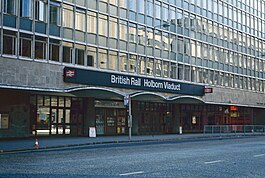Holborn Viaduct railway station
| Holborn Viaduct | |
|---|---|
 Station entrance in August 1977 | |
| Location | City of London |
| Owner | London, Chatham and Dover Railway |
| Number of platforms | 6 |
| Key dates | |
| 2 March 1874 | Opened |
| 29 January 1990 | Closed |
| Replaced by | St. Paul's Thameslink |
| Other information | |
Holborn Viaduct was a railway station in London which was opened in 1874 by the London, Chatham and Dover Railway as a new terminus to alleviate increasing usage of the nearby Ludgate Hill station.
The station became redundant with the creation of the Thameslink service in the late 1980s, and was finally closed in 1990 under British Rail, being effectively replaced by the nearby St. Paul's Thameslink station (later renamed City Thameslink).
History
During the 1860s and 1870s, Ludgate Hill had begun to struggle with increasing numbers of trains using the station. At the time, the London, Chatham and Dover Railway was suffering financial problems and was unable to raise capital to expand the station. A separate company was set up to construct a 330-yard (300 m) branch from the Ludgate Hill-Farringdon line that would terminate at a new station located on Holborn Viaduct, which would also have a new hotel forming its frontage.
Holborn Viaduct station opened on 2 March 1874 with the intention that it be used as a terminus for main line and continental trains: these services were intended to operate to both the City of London and the West End of London. Trains would travel as far as Herne Hill where they would split, with one portion going to Holborn Viaduct and the other to Victoria. Local services carried on through the Snow Hill Tunnel to join the Metropolitan Railway at Farringdon Street (now Farringdon), with a pair of low-level platforms just north of Holborn Viaduct to allow interchange with the main line services. Opened on 1 August 1874, these platforms formed a small station named Snow Hill, which was briefly renamed Holborn Viaduct Low Level in 1912.
Passenger traffic through the Snow Hill Tunnel ceased in 1916, which saw the low-level platforms closed, and Holborn Viaduct become a terminus for passenger services from the south of London into the City. The distance of just 660 yards (600 m) between Holborn Viaduct and St. Paul's station (now named Blackfriars) led to the intermediate station at Ludgate Hill being closed in 1929. The route was electrified in 1925 for services from Shortlands and Orpington.
After the Second World War, services to Holborn Viaduct began to be withdrawn. The electrification of the Kent Coast route led to two basic services operating all day from the station: to Sevenoaks and West Croydon, with peak time services to a number of other destinations. The station was rebuilt between 1960–63.[1] In 1963 the hotel, which had been heavily damaged during the Blitz, was demolished and redeveloped, with a new 10-storey office building replacing it.
In 1988 Snow Hill Tunnel was restored and passenger trains began running through as a north-south rail link through central London. Services to and from Holborn Viaduct were gradually run down as part of this plan with services operating only Monday-Friday during peak hours. The Thameslink plan was to build a new underground station in the vicinity, to be called St. Paul's Thameslink. Its construction required the demolition of the bridge to Holborn Viaduct from Ludgate Hill. Holborn Viaduct station was eventually closed by British Rail after the last train on Friday 26 January 1990. The frontage of the station buildings was incorporated into the new Thameslink station, which formed part of a new development funded by a commercial property company.
Layout

Holborn Viaduct was constructed as a six-platform terminus, with two island platforms and two side platforms, covered by a three-roof train shed. The redevelopment that began in 1963 saw the replacement of the train shed with shorter platform canopies, while a new concourse was constructed within the new office building on the ground floor level; the platforms were located at the first floor level.
The last train out of Holborn Viaduct was a special formed of two Class 411 units (8 CEP).[2] It was both an "enthusiast special" and a dedication to those involved in the Ludgate project. It visited every London terminal used at that time by South Eastern. It terminated at Charing Cross and a reception for the Ludgate project guests was held in the Charing Cross Hotel.
Gallery
-
The original station frontage, demolished in 1963.
-
The rail approach to Holborn Viaduct in 1953.
-
Holborn Viaduct from which the station took its name.
-
A 1914 Railway Clearing House map of lines around the sites of Holborn Viaduct railway station and Snow Hill railway station.
See also
References
| Preceding station | Disused railways | Following station | ||
|---|---|---|---|---|
| Terminus | London, Chatham & Dover Railway |
Ludgate Hill Line and station closed | ||
| Terminus | British Rail Southern Region City Line |
Blackfriars Line closed, station open |
- Jackson, Alan A. (1969) London's Termini. Newton Abbot: David and Charles ISBN 0-7153-5901-0
- White, H. P. (1963) "London Railway History" in: A Regional History of the Railways of Great Britain, Vol. III: Greater London. Newton Abbot: David and Charles ISBN 0-7153-5337-3
- Clinnick, Richard (2011). "London's Lost Termini". Rail (664). Bauer Media: 62–65.
- ^ McCarthy, Colin; McCarthy, David (2009). Railways of Britain – London North of the Thames. Hersham, Surrey: Ian Allan Publishing. p. 72. ISBN 978-0-7110-3346-7.
- ^ http://www.disused-stations.org.uk/h/holborn_viaduct/index28.shtml Photograph of unit 1513 as last train from Holborn Viaduct





